Are you a Quiet Speculation member?
If not, now is a perfect time to join up! Our powerful tools, breaking-news analysis, and exclusive Discord channel will make sure you stay up to date and ahead of the curve.
A few weeks ago, Wizards spoiled some of the MTG finance community’s plans to profit handily on the coming Modern season--they postponed the season by almost a year.
My initial reaction was to expect a delay in price increases on many Modern staples. This would be driven by demand shifting later to match up with the new PTQ schedule. Basic supply and demand concepts led me to this conclusion. But apparently I missed something, because many Modern staples have increased significantly since the announcement was made!
This week I want to look at which cards are seeing price movement now and which ones appear to be waiting. I’ll do my best to provide some theories as to why certain cards are moving better than others. Finally, I will discuss plans moving forward now that some price trajectories have progressed sooner than anticipated.
Recent Spikes
Many cards not printed in Modern Masters fall within this category. In fact, many speculators (including myself) did expect these to go up in price, only we were thinking it would happen during last PTQ season. After seeing the delay in Modern PTQ season this time around, I fully expected to have to wait much longer to see some investments pay out. Certain cards are bucking this trend.
Consider Worldwake manlands for example. All of these are on an upward trajectory, but Celestial Colonnade and Stirring Wildwood appear to be increasing further still during the past month, when I would have expected them to take a breather on the PTQ season schedule change.
I know these manlands see some play in Modern, but has Modern been growing this much in popularity? Are there enough Modern FNMs out there to justify the steady price rise even though Modern PTQs won't show up for over half a year?
How about Melira, Sylvok Outcast? This card was under a buck for nearly its entire life, even as the Melira Pod strategy rose to become one of the strongest in Modern. But it wasn’t until recently that this card started seeing a serious bump in price.
Inkmoth Nexus is another card seeing a recent rise in price. This causes me to pose the same question as before: is Modern really spreading in popularity this much, despite a delay in Modern PTQ season?
Other examples of recent price movement on Modern cards include Zendikar fetchlands, Daybreak Coronet, and Keen Sense.
Not Everything Is Moving Up
If the above price movement is strictly due to an increase in Modern popularity at everyone’s local hobby shop, then other Modern staples should also be rising. But some surprising cards aren’t participating in the rally.
Consider Tarmogoyf for starters:
Notice how Goyf's value has completely stagnated and even slightly declined since July? Did the jump earlier this summer already take into account all increase in demand? This was my suspicion--that the rise in demand due to a popular Modern PTQ season was already priced in. Perhaps this is why this card hasn’t moved lately while other cards (which previously had not risen as much) are on a tear.
Another surprisingly stagnant card is Inquisition of Kozilek.
Everyone thought this card would become $10, but it just hasn’t happened. Now with Thoughtseize suddenly becoming more affordable this may never happen. But the fact of the matter is that even before Thoughtseize was spoiled, Inquisition has been price-stagnant for months. If Modern demand was truly increasing, I would expect this card to participate in the rally.
How about Scars of Mirrodin fast lands? Surely these will increase in price as the Modern format grows in popularity, right? Apparently not…
I know these lands are not as ubiquitous in Modern as fetches and shocks, but I still expect them to bump up in price a little. Filter lands became very expensive lately, but these haven’t even followed in trend, let alone price! Even Razorverge Thicket, which is seeing the most play of the five fast lands, is still stagnant in price.
Understanding the Disconnect
Why are some Modern cards suddenly spiking while others are left in the dust? In my opinion, one factor alone is not the cause. Instead, many variables are likely having an impact.
How recent a card was printed is definitely significant. Cards from Future Sight and Ravnica like Horizon Canopy and Chord of Calling are older and rarer, so I understand why they’d move more readily. Meanwhile Scars of Mirrodin is still fairly recent.
Another factor may be related to deck popularity. When Reid Duke played a unique Hexproof Modern deck at the 2013 World Championship, many players took notice. The deck was also fairly cheap at the time, and I suspect it’s a lot of fun to play.
Hence the deck gains in popularity, people want the cards to build the deck, and voilà, instant price jump. It’s no coincidence that the July 31st, 2013 date coincides nicely with the recent price jump of cards in Reid’s deck, such as Horizon Canopy.
The recent rise in popularity of Reid Duke’s deck explains a lot of the recent hype, but not all of it. A white-green deck gaining traction cannot explain why Celestial Colonnade has been an interest on mtgstocks.com many times in the past couple weeks. Reid’s deck also has nothing to do with Inkmoth Nexus.
Are there other factors, then, which dictate why certain cards get their deserved “pop” in price while others remain flat? Maybe fear of reprint is a potential factor? I know I personally refuse to own Tarmogoyfs and Dark Confidants right now because I am confident more will be printed. I had the same feeling with Thoughtseize, which paid out nicely.
There are likely other factors as well. But at the end of the day shouldn’t all Modern-playable cards see a price increase going into Modern season? Barring cards currently rotating out of Standard, all Modern cards will see increased demand in the coming months. I just don’t understand why some cards are seeing increased demand now, while others are waiting on the sidelines.
Concluding with a Challenge – Spellskite
Throughout this article I’ve been completely transparent. I’ve admitted that some of these incongruities in Modern card prices have intrigued me. While some trends are obvious, such as cards in Reid Duke’s World Championship Modern deck, others are puzzling.
I’ll conclude this week’s article with a case study that embodies my point: Spellskite.
Spellskite is a powerful card in Modern these days because it helps keep so much in check. The Kiki Pod and Splinter Twin strategies suffer greatly against an opponent’s Spellskite. And with so much removal in the format, this creature ensures you can do what you need to without fearing an Abrupt Decay or Lightning Bolt.
Spellskite's utility was proven during last PTQ season. The result--it spiked to over $10 throughout the season. Then the card dipped a little as the season ended. What confuses me is how much the horror’s price has dropped even further in recent months.
This movement is opposite of many other Modern staples and I’m not sure why. Isn’t Spellskite still amazing and versatile in Modern? Melira, Sylvok Outcast and Birthing Pod are from the same set and they’ve been increasing lately, so why hasn’t Spellskite? Even Torpor Orb has been on the rise lately–-same set and also mostly a sideboard card.
Perhaps Spellskite just hasn’t had his moment yet. It’ll come--of this I am fairly certain. The same goes for fast lands and all the other Modern staples which haven’t budged in price for a while. And it’s with this expectation that I set my latest purchases towards cards which haven’t moved recently, but should be moving right along side all the other great Modern cards.
…
Sigbits
Besides Spellskite, here are some other cards which haven’t moved lately. While this is not always the case, I suspect for these cards it’ll just be a matter of time…
- I seem to recall that I used to be able to buylist Magus of the Moon for $5-$6. Now this card sells on TCG Player in this range or even a little lower. But there were three copies in the runner-up SCG Legacy Open decklist last week. In fact I’ve noticed that a turn one Blood Moon effect has risen in popularity a good deal in Legacy. The fact that Magus is Modern-legal and hasn’t been reprinted gives the 2/2 hate bear some serious upside.
- I really like Basandra, Battle Seraph. She’s a sweet legendary angel from a Commander set. Although her demand is mostly from casual players, SCG’s $3.49 price tag feels pretty low. In fact it’s lower than every price on TCG Player. I’m sitting on a few extras waiting for her price jump to come–-it may take a while, but I’ll be patient.
- Abrupt Decay is on life support. Despite being playable in Standard, Modern and Legacy, this card is only worth about one fourth its peak. Foils have also suffered a little bit, although their prices have been more robust overall. Since this is a newer card, I anticipate the wait on it to be a bit longer. But considering its versatility in Modern and Legacy I suspect this removal spell will have its day yet again.
-Sigmund Ausfresser
@sigfig8



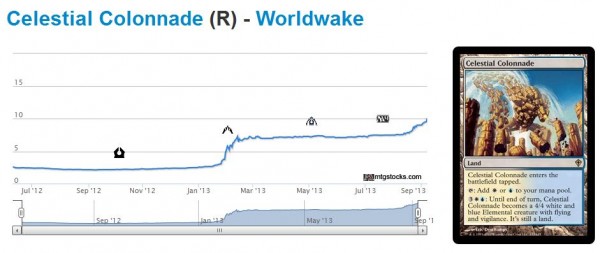
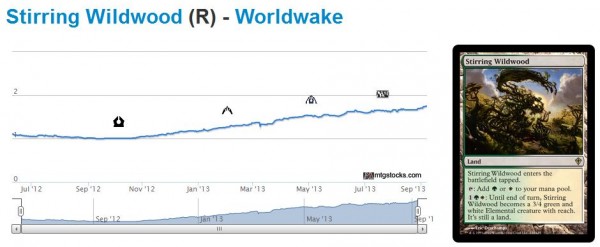
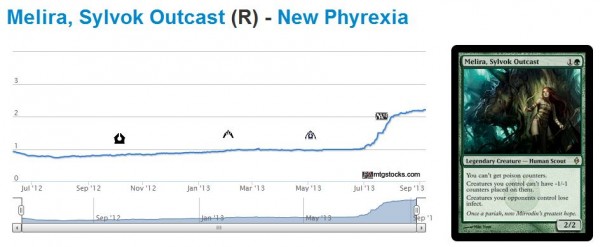
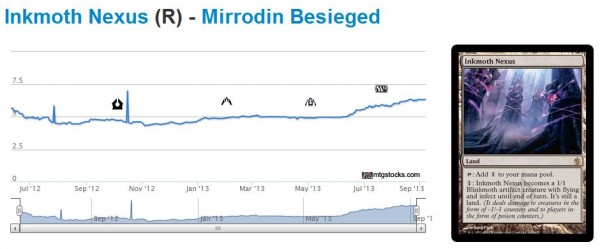
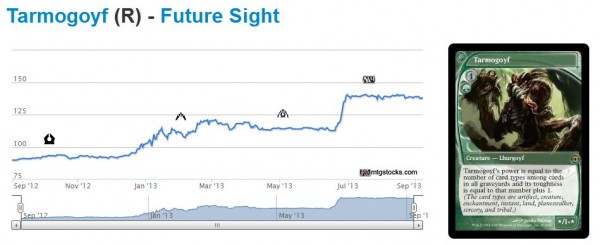
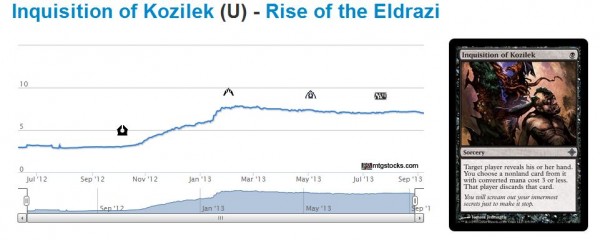
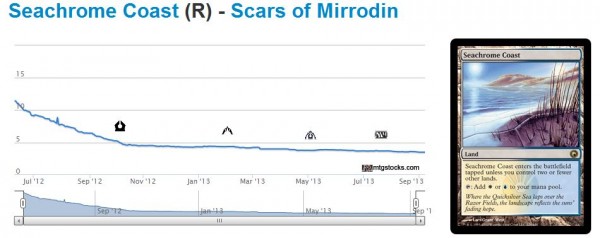
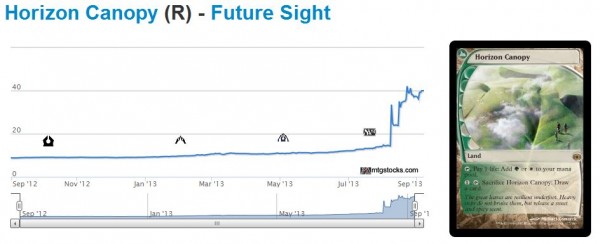
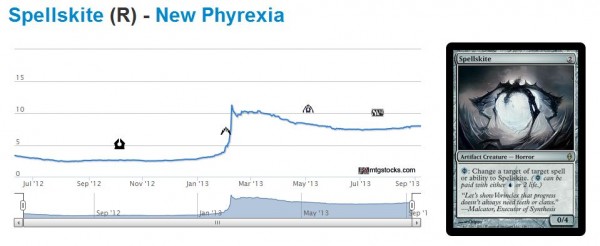
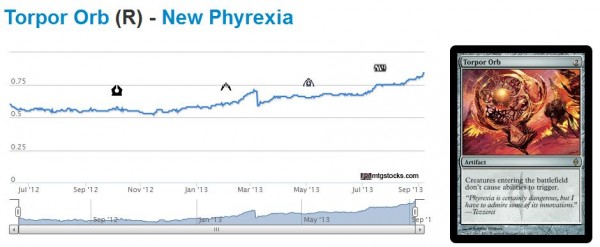



I would imagine that for Inquisition specifically the consistent rumors of Thoughtseize’s reprint may have held the price down. It was rumored to be in MMA first, then in M14 and now finally it’s being released in Theros.
I am thinking that Modern demand might at this time be fairly local. Some areas might have more of the older cards than others, so if the former has a Modern tournament coming up the players might buy anything, while if the latter has a Modern tournament come up they might be buying more older cards relatively speaking. Some areas may have larger limited or standard scenes than others, making newer cards even more widely available than you’d expect and finally we know the older cards were printed less anyway. There may also be more hoarding on older cards from us financially minded people as we know about these factors. All these factors combine into older Modern cards rising quicker, which of course makes sense intuitively.
There are other regional factors though. I know in Vintage some areas are known to have a disproportionate amount of Workshop players, while other areas have a disproportionate amount of Drain players. There is no reason for the same not to be true for Modern as well. Some areas might very well have many players locally interested in playing Pod, while others see more players interested in Jund or Soul Sisters. If an area that has many players interested in Pod is expecting a Modern tournament Pod cards may see a rise as those people start buying the pieces, leaving Jund pieces fairly untouched (for example). Obviously there will be lagrger effects as people know their respective metas and play whatever would beat Pod, but the same principle then still applies (but now people are simply also buying the cards that beat Pod).
I reckon that when Modern season is in full effect enough tournaments are ran to make the demand for format staples fairly consistent while with the season still far away these regional effects play a larger role and cause spikes in some cards, but not in others.
This is of course next to the factors you have identified in your article, such as Reid Duke’s deck.
Thank you very much for presenting your theory – I appreciate the comment.
While I agree Modern traction is fairly regional at the moment, do you really think the supply of cards is small enough for regional play to have an impact? When you talk about Workshop or Drains, you are talking about cards with print runs far less than even Tarmogoyf and Melira. It just feels like 100 players in a given region playing Pod wouldn’t drive up price this much.
But I suppose as cards get older, there are just fewer that people are readily willing to sell. It becomes more difficult for dealers to restock Modern staples as they age, so price volatility is more likely. This in fact could be consistent with your theory.
Of course I don’t have the answer. But I do agree with your prediction that as Modern season arrives, everything will generally rise together (with the right proportion of price increase consistent with deck performances). It’s just interesting to see some cards take their turn a little earlier is all
Well, Magic is booming in popularity, imagine an area where “nobody” played Magic when Ravnica was released. I think demand for Chord of Callings from that area could easily result in all cheaper copies on TCGPlayer being bought (and this might then be noticed by us and might trigger other people to buy). Not that many have to be bought to cause an effect: it would only take buying the lowest 4 NM copies on TCGPlayer to make the lowest NM go from $30 to $35, if you bought the lowest 4 NM from Magus of the Moon you’d push the lowest price from $4 to $5 (and it would only take 30 copies to take it up to $6). The effect will be most profound when the factors are combined, Pod itself might be too recent to see a big effect as many are still available, but when an older card is needed I think it adds up.
I could have mentioned Ritual rather than Drain or Shop, any of the pillars of the Vintage format really. I was referring more to a larger, regional group of people liking a certain kind of deck than the value of those cards. Vintage writers refer to such differences in regard to their tournament preparations fairly regularly.
I just wated to illustrate that many factors combine. Availability (which I’m arguing can be local), Financial interest, Competitive interest (which I’m arguing can be local), Price (not mentioned before, but not everybody can afford $125 Goyfs, some areas may even be priced out of some decks), and I’m sure there are others too. I think what we’re seeing is consistent with localized demand, so I figure that will be one of the factors influencing it, though definitely not the only factor.
I enjoyed the article and really like the questions that arise from it. I would like to point out a few factors that weren’t considered.
1.) Speculators (like ourselves)- could very well be behind some of the price swings. Melira is a great example of a very cheap card that’s necessary for a specific deck. If someone decides that they want to take the risk and buys 100-200 copies at $0.5-0.75 than naturally they will pick up the cheapest copies, thus leaving the more expensive copies on TCG player and raising the overall average price. If people look at these graphs and see the price increase they will put theirs up at $0.75-1.00 or not put them up believing they will be worth $2-3 dollars come modern season. As has been mentioned in the forums, MTG is a small enough market that it’s quite possible for people to manipulate it for personal gain (even if it is unethical) and create self-fulfilling prophecies.
2.) Manlands are quite popular in EDH. As they provide a threat post wrath (of which there are a lot). G/W and U/W are very popular color combinations and Inkmoth Nexus can serve as an alternate win condition in a lot of decks. Scars fastlands are NOT popular in EDH as the format’s slower and they tend to always come into play tapped anyways. This could help explain why the manlands are going up in value, while the fastlands are stagnant.
Hi David,
Thank you for adding your thoughts. Both of your factors make sense to me and I admittedly didn’t consider them in my article. Speculators are definitely playing a part in price movements of Modern cards. But why are speculators targeting certain cards but not others? Just based on price? Why haven’t speculators moved in on Spellskite yet, for example? I agree speculation is a major factor, and it’s likely one of many in this complicated market.
Thanks for the EDH comment – this one I completely overlooked. I hadn’t realized Man Lands were popular in Modern. This makes me like them even more (though Colonnade is getting expensive!). This does explain some of the discrepancy between man-lands and Scars Fast lands, so I really appreciate the add!
David’s first point pretty much aligns with what I was trying to say, it’s easy to buy the cheapest copies to push up the price (even incidentally: look at my examples).
As for Spellskite: speculators know it was priced much lower before. It’s one thing to buy something cheap, then resell, another to then buy again, but only slightly under what you sold them for recently hoping it will again make a big jump. That would definitely keep me from purchasing more now.
I can confirm manlands are popular in EDH, out of all cards mentioned in your article only Bassandra possibly has more appeal. It does take more experienced players to play them though. I play nearly every one I can in my decks, but many don’t realize home much value they can get from lands and just throw a bunch of basics and a few non-basics together and call it a day. I definitely agree that EDH popularity is taking a significant amount out of the market, though it’s not like everybody in U/W is going to think of playing Colonnade even if they easily could.
Not really a comment, just a nitpick – Magus of the Moon isn’t a hatebear as he costs 3. Hatebears all cost 2, hence the name.
LOL – I was questioning this myself!!! I’m so glad someone corrected me on this as I wasn’t sure. I figured he’s a 2/2 that causes problems, so I classified him as Hate-bear. I was not 100% sure if the 2 mana CC was a requirement.
I won’t make this mistake again
Great article.
I suspect as others, the price movements have nothing to do with ‘modern season’ and more to do with modern becoming more mainstream, hence Melira and man-lands being bought, which are the basic components of the commons decks.
Tarmagoyfs played heavily in Jund which is currently out of a lot of players reach due to the price of the deck in total whereas the boggle deck has some pricy cards but the deck in general can win tournaments and is a lot cheaper. The ‘goyf’ is also used heavily in Zoo decks which although close to a tier 1 deck, isn’t seen or spoken about a lot. The price may not be moving as people aren’t demanding it.
Looking specifically at SOM fastlands, I’ve seen a lot of these in binders, whereas I haven’t seen many man-lands, so maybe people are able to trade for the fastlands they need quite easily but not be able to pick up man-lands as people see them as staples in other formats and don’t put them into trade binders.
Thanks for the comment!
Is cost of entry really a problem? If so, then Wizards isn’t doing their job keeping the cost of Modern down. In Legacy I expect to be forced to play what I can afford. With Modern – a PTQ format – players should be able to select the deck they like best. If players are sleeving up Modern decks based on what they can afford, we have a problem. Don’t you think?
As for SOM fastlands – I have to imagine these dry up eventually, right?
I suspect that a combination of many of the factors mentioned here in the comments are why you see some cards exploding and others not.
I seem to be in the minorty who think speculation in Modern is kind of like playing the lottery since everything can be reprinted. I feel like a lot of the cards being speculated on are going to find their way into another set before/by next June, whether that set is the commander decks, expansions, duel decks, MM2 or spoilers from M15. I feel the moving of Modern season was deliberate to allow for more supply to catch up with an increase in demand.
Jim,
I have the same exact concerns as you. This is why I don’t own any of the big ticket Modern cards AND why I’m struggling with whether or not I should sell my other cards that spiked. Colonnade was actually the main card that caused me to write this article. I own a couple sets and 3 set foils – not a ton, but enough to have profited nicely. I’ve enjoyed the latest run up in price and I look forward to cashing out. But what perplexes me is how these have been going up DESPITE the delay in Modern Season. Does that mean these will only go up higher in 8 months? What is the impact of reprint risk? How much of a gamble is it really? I don’t anticipate Manlands would be the first cards on the reprint list in Wizards’ mind, so they feel kind of safe, no?
Thanks for the comment – you are right in line with my own thoughts.
There are several factors you need to consider for card reprint potential.
1.) If printed in a standard legal set, would the card prove to be too good…the beauty of the older formats is that they weed out the weaker cards down to a much smaller card pool (usually). So reprinting a modern staple in a standard legal set runs the risk of warping the standard environment, however, it’s only these types of mass reprintings that greatly drop a cards value. Reprinting a card in a specialty deck (like the Planechase ones) wouldn’t cause it’s price to drop considerably like it does when it shows up in a standard legal set.
2.) Does the card contain mechanics/names that would feel out of place in new sets. This is one reason why I think Chord of Calling has jumped so high despite the modern season being a long ways away. It’s unlikely that convoke would be reprinted in a standard legal set (I think this one has a solid shot of showing up in one of the commander decks though). Another good example is Inquisition of Kozilek, as it has an Eldrazi’s name in the title, it would be very ackward to reprint in a standard legal set w/o referencing the Eldrazi. Phyrexian Mana is another good example (hence why a Spellskite reprint is far less likely than one of Torpor Orb)
3.) Can the card be “replaced” by a newer version instead of reprinting the old? I feel like Deathrite Shaman replaces Noble Heirarch in a LOT of decks, as it provides mana of any color as well as provides other utility. Losing exalted and the ability to always tap for mana was a fair trade for +1/+1 and all the other abilities.
I mention these because I consider these when investing in MTG cards for speculative purposes, given my previous article in which I broke down the typical drop in price for a reprint, it makes a lot of sense to determine the likelihood of a reprint before investing.
Modern is the easiest format to speculate on.
I noticed a simple trend in Modern. If price is high: sell. If price is low: buy.
This does not work in standard or legacy.
For a certain card in modern, use this checklist:
card played? yes –> price low? yes –> buy/trade
legacy cards: you can speculate on old cards, but that’s mostly risky.
you can speculate on new cards, but those are modern cards too (abrupt decay).
standard cards: standard prices fluctuate too fast (jace, architect of thought). You can invest in a card that is played, but if the price doesn’t jump before rotation, you’ll lose money. If you don’t sell fast enough, you lose money. A new set makes the format too unpredictable for speculation.
Also, this summer was the best proof how safe modern bets are:
it’s summer, modern season is delayed, but still we see prices go up. That’s clearly promising for this eternal format.
Fetchland are very high in price now. In standard, it would be too late to sell them now, but in Modern, you can still sell them.
Only thing you shouldn’t do is be too greedy and hope they are higher next year. We all know they are going to reprint them in the future. Make money now, and let them dump the price. After that, prices will go up again.
That’s why we buy shocklands last 6 months.
Paper price movements might be well explained by modo redemption. Melira and Inkmoth Nexus are from MBS, which closed to redemption in the spring. We could be seeing price increases on these because supply is now mostly static.
On the other hand, supply of SOM and NPH is more dynamic due to redemption being open still. This might explain why prices on cards from these sets are more sluggish. Demand for cards from these sets goes up, supply goes up in response, muting any price increases or in the case of the fastlands, bringing prices down further.
Torpor Orb is acting differently, but I’d be hesitant to extrapolate price movement on a single card into any broader trend.
Matthew,
Thanks for adding this MTGO perspective. Since I’m not on MTGO, I wasn’t aware of the differences in redemption dates. Why would SOM and NPH redemption continue on while MBS ends sooner? Is there rationale behind this? Certainly this is worth pursuing further. What other sets will be exiting redeemability in the near future?
SOM, NPH and M12 will no longer be redeemable as of Nov 4th. Scroll to the bottom of the link for other dates.
http://www.wizards.com/magic/digital/magiconline….
“As a general rule, Magic Online sets will be available for redemption roughly one month after they are released. If a redeemable set runs out of stock before its Redemption Guarantee Date, the set will be reprinted. After a redeemable set’s Redemption Guaranteed Date has passed, such set will be available while supplies last or until its Cutoff Date, whichever comes first.”
What happened this year was that WoTC ran out of paper MBS sets in the early spring. Once that happened, you could no longer redeem MBS sets through the online store. There was a small announcement in the WoTC forums, but it was easy to miss. SOM and NPH are still available for redemption. MBS is the only set in recent memory that WoTC ‘ran out of’ before the cutoff date.
It’s quite possible that the fastlands are staying low in price because of redemption, though this is hard to prove. I could imagine that SOM sets are being redeemed for cards like Mox Opal, and the fastlands are meeting demand, keeping prices on those depressed. It could be that after redemption closes, we start to see some price strength in these lands. It will be interesting to watch.
Hmm.. link is not working, just search ‘redemption cutoff date mtgo’ in google, it’s the first link.
Thanks for the info! This is definitely worth exploring further. I sense a collaborative article in the future
I see you like my Torpor orb and spellskite calls ;). Its not that these cards won’t spike, its just that they have not yet, i.e. buy-in now. There is also a Modern GP this weekend, so I think people are on a holding pattern until Sunday night. I would expect a couple things to go crazy at least
Yes I very much like Torpor Orb under $1 and Spellskite Good to see we are in agreement. This weekend’s GP should be very interesting to monitor. I suspect multiple cards will be moving in price in response to any successful decks, especially if new cards are showcased!
Good to see we are in agreement. This weekend’s GP should be very interesting to monitor. I suspect multiple cards will be moving in price in response to any successful decks, especially if new cards are showcased!